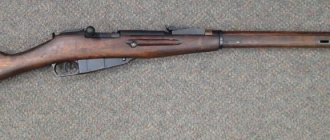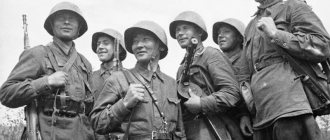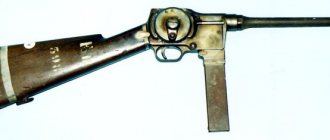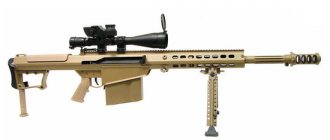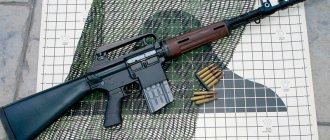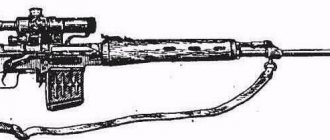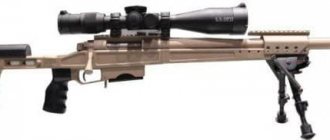Type of bolt action rifle
| MAS-36 | |
| The MAS-36 rifle was produced after the Great Patriotic War. From the Swedish Army Museum. | |
| Type | Bolt-action rifle |
| Place of origin | France |
| Service history | |
| In service | 1936–1979 (France) 1936–present |
| Used | See Users |
| Wars | World War II First Indochina War Vietnam War Algerian War Suez Crisis Ifni War 1958 Lebanon Crisis Laotian Civil War Chadian Civil War Nigerian Civil War Cambodian Civil War Western Sahara War Lebanese Civil War Chadian-Libyan Conflict Tuareg Uprising (1990-1995) Syrian Civil War Central African Civil War (2012–present) |
| Production history | |
| Designed by | 1927-1936 |
| Manufacturer | Manufacture d'armes de Saint-Étienne |
| Produced | 1937–1952 |
| No. built | 1 100 000 |
| Characteristics | |
| Weight | 3.72 (8.2 lb) unloaded |
| Length | 1020 mm (40.16 in) |
| Barrel length | 575 mm (22.64 in) |
| Cartridge | 7.5 × 54 mm French |
| Action | Gate |
| starting speed | 850 m/s (2,789 ft/s) |
| Effective firing range | 400 m (440 yd) with scope |
| Feeding system | 5-round wire stripper, internal magazine |
| Attractions | Iron sights |
MAS Modele 36
(also known as
the Fusil repeat 7 mm 5 M. 36
[1]) is a military action rifle. First adopted in 1936 by France and intended to replace the Berthier and Lebel series service rifles, it was in use well before World War II. It was produced from late 1937 at the Manufacture d'Armes de Saint-Étienne (MAS), one of several state-owned arms factories in France. Only 250,000 MAS-36 rifles were available to equip French infantry during the Battle of France in 1940. Mass production was finally achieved after World War II, and MAS-36 rifles saw widespread service during the First Indochina War, the Algerian War, and the Suez Crisis. In total, at the time of production cessation in 1952, about 1.1 million MAS-36 rifles were produced.
Description[edit]
Before the Great Patriotic War, MAS-36 was produced
The MAS-36 is a short-barreled carbine-type rifle with a split stock and a flat receiver. It is chambered for the modern 7.5×54mm cutless French cartridge; shortened version of MAS 7.5 × 57 mm mod. The 1924 cartridge, which was introduced in 1924 (then modified in 1929) for the French FM 24/29 light machine gun. The rifle was developed based on the French experience of the First World War and combines various features of other rifles, such as the two rear locking lugs of the British rifle SMLE (easy to clean and smudge resistant), dog leg
British P14. /US M1917 Enfield rifle, which placed the bolt handle in a comfortable ergonomic position in relation to the trigger and sights, and a five-round box magazine (claw extractor) of the German Gewehr 98, which stored 5 rounds in a staggered pattern and fed 5 rounds of stripper ) to obtain an "ugly, crudely made, but extremely durable and reliable" service rifle. [2]
There are five removable parts in total: a cross-shaped Lebel type bayonet inserted into the protective tube under the barrel (taken out with a stopper and rotated by snapping the stopper into the tube to secure it), the bolt body, the rear of the bolt. cap, firing pin and firing pin spring. The metal parts of the rifle were baked in the oven.
The MAC-36's bolt handle was "uncomfortably" bent forward to put it in a comfortable position for the soldier's hand. Some have since been found bent back into a face-down position, like many other bolt-action rifles. [3] The MAS-36 had a relatively short barrel and was equipped with large aperture (rear) and center (front) sights designed for typical combat ranges. Typical of French rifles of the period, the MAS-36 did not have a manual safety. [4]
The rifle was designed with an iron sighting line consisting of a tangent aperture rear sighting element that was calibrated for 7.5×54mm French mle1929 C cartridges at 100–1,200 m (109–1,312 yd) in 100 meter (109 yd) increments. . . The original front sight was milled and consisted of a front post protected by two open "lugs". There were 25 rear aperture elements available for the line of sight to optimize windage and windage in 2.32 MOA increments when assembled on the armory. These rear aperture arsenal elements moved the aiming point 13.5 or 27 cm (5.3 or 10.6 in) left or right, up or down, at a range of 200 meters (219 yd). It is worth noting that the front part of the stock is the most important component of setting up the sight on the MAS-36. To prevent disassembly of the front stock, custom wrench screws were used on the barrel band and nose caps. Only gunsmiths produced suitable screwdrivers for removing the front stock. If you remove the front stock, you will likely have to deal with a lot of trial and error getting the screws back into their exact positions.
It was usually carried with a loaded magazine and an empty chamber until the soldier engaged in combat, although the rifle's trigger could be locked by raising the bolt handle. The MAS-36 had a 17-inch spike bayonet inverted in a tube under the barrel. To use the bayonet, a spring pusher was pressed to release the bayonet. It could then be pulled out, unfolded, and reinserted into the socket. The original implementation of this bayonet design has an excellent (though unusual [5](discovered)) flaw: when storing a bayonet in one rifle and an empty bayonet in the other, the top of the stored bayonet could be locked into the second rifle's empty bayonet. This obscures the release button on bayonet and leads to irreversible (at least until destructive disassembly) pairing of rifles. In the post-war period, the French updated the bayonet storage design by drilling a hole in the bayonet, which allowed the latch to be pressed through an already drilled hole in the bayonet cap. [5] Like the Lebel rifle Model 1886, the MAS-36 featured a stowage hook offset to the right side of the barrel to allow multiple rifles (usually a trio) to stand vertically.
Characteristics of the MAS-36 Rifle
| A country: | France |
| Type: | Rifle |
| Date of issue: | 1936 |
| Caliber: | 7.5 mm |
| Length: | 1320 mm with bayonet, 1040 mm without bayonet (575 mm barrel) |
| Weight: | 3.76 kg (unloaded, without bayonet) |
| Rate of fire: | No information |
| Initial bullet speed: | 820 m/s, sighting range: 1200 m. |
| Ammunition: | 5 rounds 7.5×54 mm |
Background [edit]
The MAS-36 was intended to be a cost-effective, simple bolt-action rifle to serve rear echelon, colonial and reserve forces, and was intended to be jointly processed and created a new standard semi-automatic rifle before the next big conflict. The first French semi-automatic rifle evolved from the MAS-38/39 prototype. A limited number of MAS-40 semi-automatic rifles entered military service in March 1940. The Battle of France and the subsequent German occupation of France prevented the large-scale introduction of semi-automatic service rifles among front-line French troops. In the 1950s, the French military adopted the MAS-49 semi-automatic rifle as its standard service rifle.
Although it was intended to replace the Lebel Model 1886 and Berthier rifles and Berthier carbines, budgetary constraints limited production of the MAS-36, and it served alongside the former rifles in many French army and colonial units. During World War II, the MAS-36 was used alongside Lebel 1886s and Berthiers during the Battle of France. After the Battle of France, the Germans acquired large numbers of MAS-36s, which were designated Gewehr 242(f)
and were adopted by their own garrison units based in occupied France and later by the Volkssturm. [4]
Combat use
At the time of the Franco-Prussian War of 1870-1871, the French managed to develop a more advanced weapon than the Dreyse rifle (before that, the Dreyse rifle was considered to be one of the best examples of handguns in Europe). The Dreyse rifle had been in service for more than 20 years, had a relatively large caliber and, as a result, poor ballistics, so that the effective range of fire from it was significantly inferior to the French small-caliber Chassepot system. The Dreyse rifle was not replaced for one reason - it performed well in battles against the Austrians in 1866, who were still armed with muzzle-loading rifles. The Chassepot rifle was indeed superior to any German development at that time, however, the French troops, unlike the German ones, were not completely re-equipped with these rifles, which accounted for only 20-30% of the total weapons of the French army.
During the Battle of Saint-Privat - Gravelotte, the French, having taken up convenient positions, fired at German soldiers with Chassepot rifles from a distance of 1200 m. The Germans, advancing in dense formation, suffered huge losses. The Prussian Dreyse rifle could only fire at a range of about 600 m, and Prussian soldiers had to travel long distances in heavily shot terrain before they could open fire. The German commander-in-chief von Moltke, who had not organized reconnaissance of the enemy's terrain and dispositions, was now paying for his negligence. The Germans suffered huge losses and did not achieve significant successes, despite their great numerical superiority. Only in the evening were the Guards Corps and brigades of the 9th and 10th Corps able, with the support of German artillery (French artillery was completely suppressed by German artillery), to break through the French positions.
Comparative characteristics of the Prussian Dreyse rifle and the French Chassepot
| Weapon | A country | Year of issue | Years of use | Length | Weight | Weight (charged) | Caliber | Rifling | Magazine capacity | Rate of fire | Initial bullet speed | Sighting range | Muzzle energy of a bullet |
| Dreyse rifle, model 1849 | Prussia | 1836 | 1848-1871 | 1422 mm | 4.1 kg | 4.7 kg | 15.43 mm | 4 right | manual chuck feed | 5 rounds per minute [ source not specified 391 days ] | 295 m/s | 600 m | 850-950 joules [ source not specified 391 days ] |
| Chassepot rifle | France | 1866 | 1867-1874 | 1314 mm | 3.7 kg | 4.6 kg | 11.43 mm | 4 right | manual chuck feed | 19 rounds per minute [ source not specified 391 days ] | 405 m/s | 1200 m | 1100-1200 joules |
Further development[edit]
Rifles produced after World War II feature manufacturing simplifications such as stamped nose caps with a closed front sight, stamped magazine bottom covers, stamped ring front suspension, a guard measure to prevent dirt from getting into the trigger area, and a side-mounted cam guide and button for dialing and fixing the selected firing range on the sight. The hooded front sight reduced glare in adverse lighting conditions and added additional protection to the rack. The bolts of post-World War II rifles cannot be closed into an empty chamber, indicating that the rifle must be reloaded. Later post-war batches have a phosphating/parker treatment, introduced as a more effective anti-rust metal surface treatment. The "Second Model" is the most produced version with its derivative MAS 36/51.
Post-war use[edit]
In service with the French Police Mobile Gendarmerie during the Battle of Larzac in 1978.
The MAS-36 was used extensively by the French Army and Colonial Defense Forces during post-war French counterinsurgency operations in the first Vietnam War and the Algerian War, [6] as well as in the Suez Crisis. [7] During the Suez Crisis, French paratroopers from the 2nd RPC
(
Régiment de Parachutistes Coloniaux
) used scoped MAS-36 rifles to kill enemy snipers. [8] The MAS-36 remained in service until the early 1960s as an infantry rifle, often serving with local colonial units. It was the official replacement for the standard rifle after France adopted the semi-automatic MAS-49 series of rifles in 1949, although the bolt design remained in the special sniper version of the rifle, the FR F1 (now chambered in 7.62×51mm NATO) and its successor - the FR F2 sniper rifle.
Gabon and Ivory Coast continued to use post-independence MAS-36; In 1968 and 1969 they supplied Biafra with MAS-36 rifles during the Nigerian Civil War. Haiti donated 300 rifles to Biafra at the end of the conflict. [9]
After World War II, versions of the civilian hunting rifle were produced by MAS and gunsmith Jean Fournier. These semi-loading rifles were chambered in 7x54mm Fournier (common, 7.5x54mm reduced to 7mm), 7x57mm Mauser (very rare), 8x60mm S (rare) and 10.75x 68 mm (rare). Hunting rifles of the last two calibers had built-in muzzle brakes. Also imported into the US were several military surplus MAS-36 rifles converted to 7.62x51mm NATO from 7.5x54mm. These rifles were modified for NATO cartridges and also had an SKS type trigger safety.
In the Comoros, the French had a decent number of MAS-36 rifles in storage during World War II and the post-war era. When Comoros became an independent state in 1975, the rifles were transferred to the new Comoros Army. The MAS-36 was widely used during the many coups and attempted coups that took place in the island nation from 1975 to 1989. Following the reform of the Comoros Army in 1990, the MAS-36 was replaced by newer assault weapons such as the AK-47. [10]
In 1941, Great Britain and Free France occupied Syria, taking with them thousands of MAS-36 rifles. When French troops left Syria in 1946, the rifles were given to the Syrian armed forces to equip their army and militias, as the Syrian government was perceived as pro-Western at the time. The MAS-36 was used extensively by Syrian forces in the 1948 Arab–Israeli War. The Israeli victory and then the coup in Syria led to Syria's loyalties shifting to the Soviet Union rather than Western countries. After purchasing large quantities of Soviet weapons in the 1950s and 1960s, the MAS-36 became obsolete, with thousands of units being sent to government warehouses. In 2011, during the Syrian Civil War, Syrian opposition forces seized thousands of stored rifles. With almost all rifles still in working order, the Free Syrian Army used the MAS-36 extensively from 2011 to 2015. Since 2015, the Free Syrian Army has been reducing its use of the MAS-36 due to a shortage of rifles. mm ammunition. [10]
Sniper rifles FR F1 and FR F2 [edit]
The French FR F1 and FR F2 sniper rifles use the same basic bolt design as the MAS-36 infantry rifle. However, the MAS-36's action was significantly modified and strengthened to reduce accuracy by preventing flex in these sniper rifles.
Characteristics of the Gamo Mach1 PigMan air rifle
The company itself puts the merger of two technologies behind the brand name of the new product “Mach1”.
Firstly, the use of a huge 33x100 compressor. Cylinders of this diameter (33 mm) have not previously been used by any manufacturer in production rifles. The basis is also taken from the recent development of rifles that seem to be intermediate between “magnums” (25x100) and “supermagnums” (29x120). These include the already mentioned “Gamo Bone Collector”, intended for the American market, as well as the European “black series” - “Black Knight”, “Black Fusion” and “Black Bull” - with a 29x100 compressor (see “Postscript for the supermagnum” ).
Frankly, the information about these new compressors is somewhat contradictory. Americans traditionally do not like to delve into the “guts” of their pneumatics; the still rare European owners of “Mach1” rifles (mostly my pen pals from Holland and Lithuania) are also in no hurry to share the results of real measurements of the same internal diameter. Therefore, for now we have to take as a basis the enthusiastic advertising and meager technical descriptions of Gamo itself.
Secondly, the Spaniards install a proprietary gas spring based on dried nitrogen IGT (Inert Gas Technology) with carefully selected characteristics in all rifles in this series.
The result was a weapon that reached the level of classic “supermagnums” in terms of speed/energy. And this is with a smaller compressor volume, smaller dimensions and better accuracy characteristics. At the same time, its price is significantly lower than that of its elite competitors - Diana 350, Gamo Hunter 1250 and even Benjamin Trail NP XL-1500, although, of course, it exceeds the cost of the Turkish Khatsan 125 and the Chinese Smersh P4 "
According to the 177 caliber (4.5 mm), it produces a speed of 1420 fps, or 433 meters per second! True, this is a rather annoying 0.28 grams (more details - “Bullets for pneumatics and shooting features”). In the US standard .22 caliber (5.5 mm) – 1055 fps, or 322 m/s. This is a very serious indicator, but, as in the previous case, it is achieved with the ultra-light “Gamo Raptor Platinum” 9.7 Grain (0.63 grams), which is very unhealthy for powerful pneumatics and resembles digging trenches with a child’s shovel.
Options [edit]
- MAS 36 CR39
- MAS 36 with a folding hollow aluminum stock, intended for use by airborne troops. - MAS 36 LG48
- An MAS 36 equipped with a reinforced barrel and a 48 mm rifle grenade launcher used in the first Vietnam War. - MAS 36/51
- MAS 36 with a reinforced barrel and a 22 mm NATO standard rifle grenade launcher. - Fusil modèle FR-G2
- A heavily modified MAS-36 rifle equipped with a match barrel with a harmonic canceler and a telescopic sight for use by designated shooters, used as a stopgap while the FR F1 rifles were rebuilt into the FR F2.
Users[edit]
Polisario Front fighters with MAS-36 in 1980.
Polish soldiers with MAS 36 rifles, France, 1940.
- Algeria [10]
- Benin [10]
- Biafra [9]
- Burkina Faso [10]
- Cambodia [10] [11]
- Cameroon [10]
- Central African Republic Central African Armed Forces [12] [10]
- Central African National Police [12]
- Seleka [13]
- Free French Forces and French Resistance [15]
- Compagnie des Carabiniers du Prince
. Issued to occupation units in France [19] and Volkssturm units. [15]
Links[edit]
- ↑ Manuel du Grade TTA 116
(in French). Berger-Levro. March 19, 1956 p. 207. - ↑
Jane's Guns Recognition Guide, Ian Hogg & Terry Gander, Harper Collins Publishers, 2005, p. 238 - 20th Century Military Small Arms, 7th Edition, Ian W. Hogg and John S. Weeks, Kruse Publications, 2000, p. 182
- ^B Bishop, Chris (2006). Encyclopedia of Small Arms and Artillery
. Grange Books. paragraph 47. ISBN 978-1-84013-910-5. - ^ ab French Finger Trap: MAS-36 Bayonet Shenanigans, retrieved February 20, 2022
- "L'armement français en AFN" Gazette des Armes
(in French). No. 220. March 1992. pp. 12–16. - McNab, Chris (2002). Military uniform of the twentieth century
(2nd ed.). Kent: Grange Books. p. 85. ISBN 1-84013-476-3. - Leuliette, Pierre, Mikhailovsky and the Dragon: Memoirs of a Trooper
, Houghton Mifflin (1964) - ^ a b c d e Jowett, Philip (2016). Modern African Wars (5): The Nigerian-Biafran War 1967-70
. Oxford: Osprey Publishing Press. ISBN 978-1472816092. - ^ abcdefghijklmnopqrstu vwxyz "Use of the MAS-36 Rifle after World War II: Part II (Export Users)". wwiiafterwwii.wordpress.com
. August 23, 2015. Retrieved June 15, 2022. - Kutcher, Philip (24 July 1980). Armies of the Vietnam War 1962–75. Fighters 104. Osprey Publishing. clause B.3. ISBN 9780850453607.
- ^ ab Berman, Eric; Lombard, Louise (2008). "Central African Republic and Small Arms: Regional Gunpowder" (PDF). Geneva: Small Arms Review. Archived from the original (PDF) on March 24, 2022. Retrieved March 24, 2017.
- Touchard, Laurent (December 17, 2013). "Centrafrique: le Soudan at-il armé les ex-Séléka?" . Jeune Afrique
(in French). - "31 July 1970: baptême du feu pour le 4ème commando". L'Elephant Noir
(in French). No. 22. September 2011. pp. 5–8. - ^ abcd "Use of the MAS-36 rifle after World War II: Part I (French users)". wwiiafterwwii.wordpress.com
. August 23, 2015. Retrieved June 15, 2022. - ^ ab Conboy, Kenneth (23 November 1989). Laotian War 1960–75. Action 217. Osprey Publishing. clause 15. ISBN 9780850459388.
- Small Arms Review (2005). "Sourcing the Weapons of War: Small Arms Supply to Conflict Zones" (PDF). Small Arms Review 2005: Guns at War. Oxford University Press. item 166. ISBN. 978-0-19-928085-8.
- Giletta Jacques (2005). Les Gardes Personnelles des Princes de Monaco
(1st ed.). Taurus editions. ISBN 2 912976-04-9. - Jump up ↑
Bishop, Chris (1998). Encyclopedia of weapons of the Great Patriotic War. New York: Barnes & Noble Books. paragraph 222. ISBN 0760710228. OCLC 40924461. - Collateral, Steven J. (1982). Polish Army 1939–45. Fighters 117. Osprey Publishing. paragraph 36. ISBN 9780850454178.
- Ignacio Fuente Cobo; Fernando M. Mariño Menéndez (2006). El conflict del Sahara occidental (PDF) (in Spanish). Ministerio de Defensa de España and the Carlos III University of Madrid. p. 69. ISBN 84-9781-253-0. Fuente and Marinho.
- Small Arms Review (2015). "Red Flags and Buicks: The World's Firearms Supplies" (PDF). Small Arms Review 2002: Calculating the Human Cost. Oxford University Press. paragraph 82.
- https://www.calibreobscura.com/covert-operations-the-arms-of-isis-insurgents-in-syria-2019/
Characteristics of the Gamo Mach1 PigMan air rifle
The company itself puts the merger of two technologies behind the brand name of the new product “Mach1”.
Firstly, the use of a huge 33x100 compressor. Cylinders of this diameter (33 mm) have not previously been used by any manufacturer in production rifles. The basis is also taken from the recent development of rifles that seem to be intermediate between “magnums” (25x100) and “supermagnums” (29x120). These include the already mentioned “Gamo Bone Collector”, intended for the American market, as well as the European “black series” - “Black Knight”, “Black Fusion” and “Black Bull” - with a 29x100 compressor (see “Postscript for the supermagnum” ).
Frankly, the information about these new compressors is somewhat contradictory. Americans traditionally do not like to delve into the “guts” of their pneumatics; the still rare European owners of “Mach1” rifles (mostly my pen pals from Holland and Lithuania) are also in no hurry to share the results of real measurements of the same internal diameter. Therefore, for now we have to take as a basis the enthusiastic advertising and meager technical descriptions of Gamo itself.
Secondly, the Spaniards install a proprietary gas spring based on dried nitrogen IGT (Inert Gas Technology) with carefully selected characteristics in all rifles in this series.
The result was a weapon that reached the level of classic “supermagnums” in terms of speed/energy. And this is with a smaller compressor volume, smaller dimensions and better accuracy characteristics. At the same time, its price is significantly lower than that of its elite competitors - Diana 350, Gamo Hunter 1250 and even Benjamin Trail NP XL-1500, although, of course, it exceeds the cost of the Turkish Khatsan 125 and the Chinese Smersh P4 "
According to the 177 caliber (4.5 mm), it produces a speed of 1420 fps, or 433 meters per second! True, this is a rather annoying 0.28 grams (more details - “Bullets for pneumatics and shooting features”). In the US standard .22 caliber (5.5 mm) – 1055 fps, or 322 m/s. This is a very serious indicator, but, as in the previous case, it is achieved with the ultra-light “Gamo Raptor Platinum” 9.7 Grain (0.63 grams), which is very unhealthy for powerful pneumatics and resembles digging trenches with a child’s shovel.
With slightly more serious, and also truly normal for 22-caliber ammunition, according to the results of control shootings carried out by American weapons experts, the situation is as follows.
| Bullet | Speed |
| H&N Field Target Trophy Green 10.03 Grain (0.65 g) | 1039.02 FPS (317 m/s) |
| RWS Hobby 11.9 Grain (0.77 g) | 910.60 FPS (278 m/s) |
| Crosman Premier HP 14.3 Grain (0.93 g) | 829.45 FPS (253 m/s) |
| JSB Jumbo Exact 14.35 Grain (0.93 g) | 799.53 FPS (244 m/s) |
| H&N Field Target Trophy 14.66 Grain (0.95 g) | 813.49 FPS (248 m/s) |
| H&N Baracuda Match 21.14 Grain (1.37 g) | 621.70 FPS (189 m/s) |
The performance is really quite good for a spring-piston rifle. Of course, it is far from the capabilities of PCP pneumatics, but for real hunting (not for cleavers) it is quite suitable. Including accuracy.

